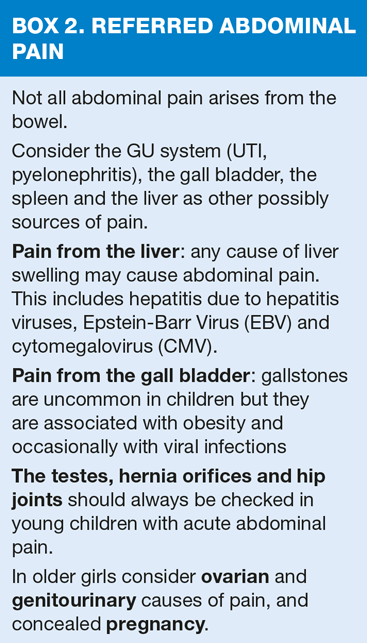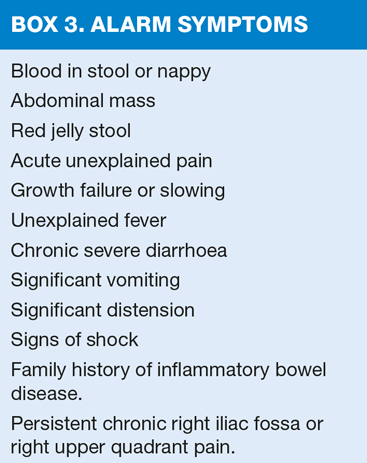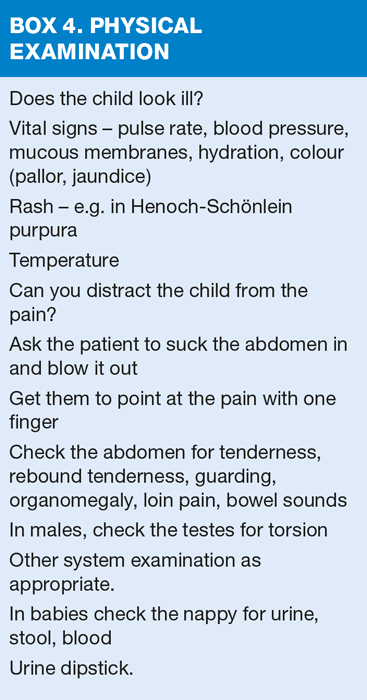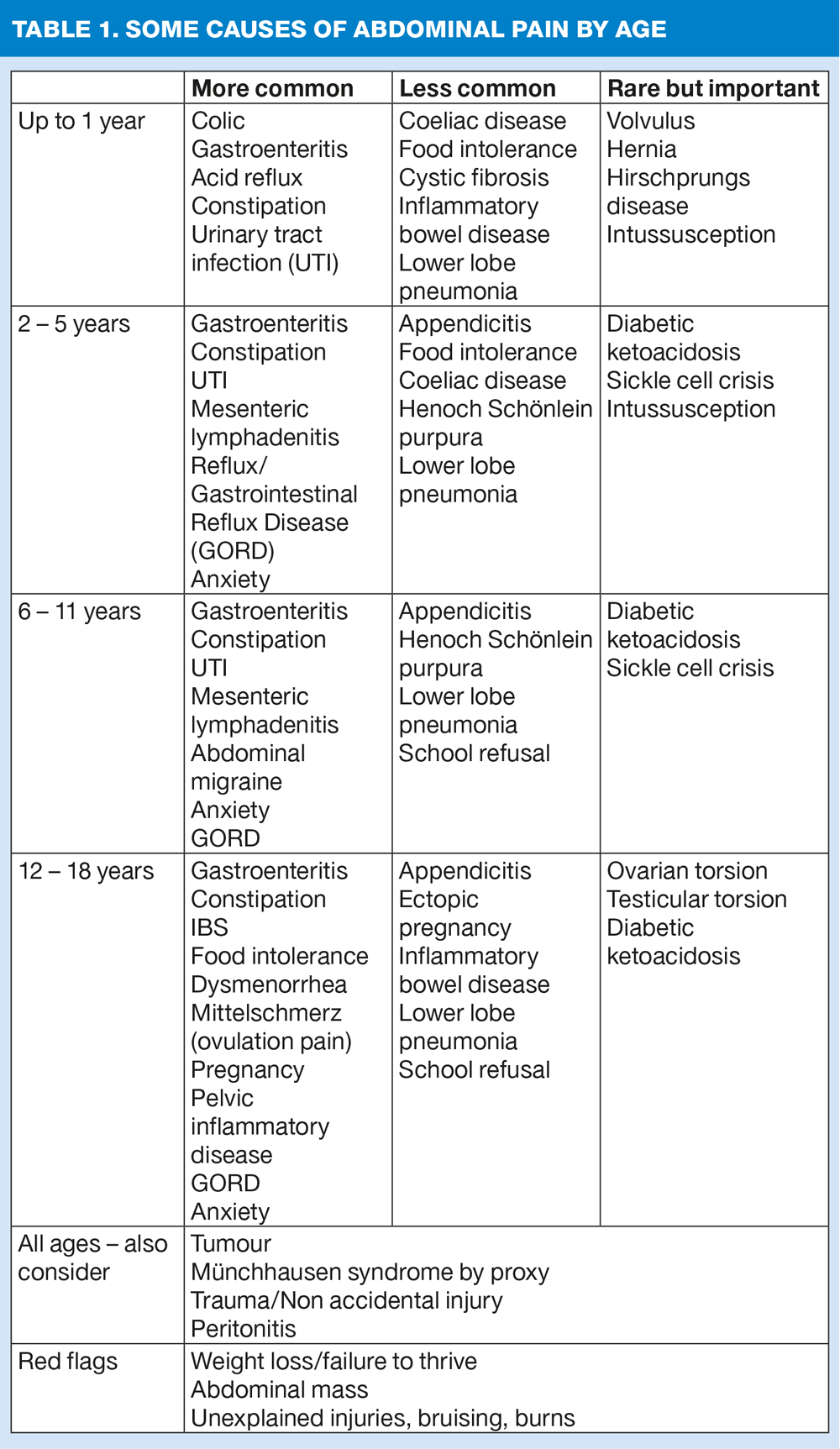The child with abdominal pain
Dr Mary Lowth
Dr Mary Lowth
MA MB BCh FRCGP PGCMedEd
GP, MRCGP examiner and medical educator
Assessing children with abdominal pain, managing those with self-limiting conditions and spotting those with more serious conditions: a Practice Nurse guide
Abdominal pain is extremely common in children. It will frequently present to the practice nurse in urgent and triage clinics. Nurses may also be consulted about chronic or recurrent abdominal pains in children attending for other more routine appointments.
There are two reassuring things:
- Most children presenting with abdominal pain will not have a serious or life-threatening underlying cause.
- Most children in whom there is a serious issue will have other symptoms and signs suggesting this to be the case.
However the practice nurse needs to know how to assess children with abdominal pain, how to manage those with non-serious self-limiting conditions, and how to spot those who may have significant disease.
DIAGNOSIS BY AGE
Neonates and babies may simply present with crying and distress. The history comes from the parent, and will be a description of the way the child behaves with the pain, rather than a description of the pain.
Toddlers can usually answer simple questions but may not be able to localise or describe pain well.
Teenagers may be embarrassed to talk about the pain — they are often embarrassed by all medical issues, not just those that relate to sexual health. Questions regarding constipation or urinary frequency may be excruciating for them, and you may have to ask quite closed questions (e.g. how often do you pass urine?) rather than open ones (do you have any other symptoms) in order to find out whether they have relevant symptoms.
CAUSES OF ABDOMINAL PAIN
Most abdominal pain in children comes from the gut and the structures round the gut. Gut pains tend to be colicky — it comes and goes in waves or spasms, but children may describe this poorly.
ABDOMINAL PAIN IN BABIES
Colic
Up to 30% of all babies show symptoms of colic and it is one of the most common reasons for parents to consult about their baby.
Colic starts gradually rather than suddenly, typically between 3 weeks and 4 months of age. Babies have episodes of inconsolable screaming, often with drawing up of the knees, redness of the face and passing of wind. The baby is otherwise well and gains weight normally. He or she will be fine between crying episodes, which are often in the second half of the day, and will be feeding and developing normally.
Before diagnosing colic other serious causes of pain and illness (such as testicular torsion, hernia or intussusception) must be ruled out.
ACUTE ABDOMINAL PAIN
This can be difficult to diagnose, particularly in young children, and where doubt about diagnosis remains hospital admission may be necessary. It is particularly important not to delay or miss the diagnosis of appendicitis in young children, as they can progress rapidly to perforation. Significant tenderness, guarding or rebound generally need admission. Appendicitis is very uncommon under the age of 3 years. The usual history is of anorexia, vomiting and central abdominal pain which moves to the right iliac fossa; there is a low-grade fever, pain aggravated by movement and tenderness with guarding.
Mesenteric adenitis is a common cause of nonspecific abdominal pain in younger children, which resolves within 48 hours. There is often an accompanying URTI. It is due to viral infection, which causes swelling and inflammation of the mesenteric glands around the bowel. Children will have a short history, and if the mesenteric glands are swollen they may well have swollen cervical glands to match: finding these can help explain the likely diagnosis to the parent. The symptoms will be poorly localised. There may be mild tenderness but no guarding or rigidity.
Intussusception is a rare but important cause of acute abdominal pain, caused by one part of the bowel telescoping into the part ahead of it. This cuts off the blood supply and leads to ischaemia. It's very serious and must be considered in the diagnostic sieve. Classically children pass a jelly red stool, but in practice this doesn't happen often, and only late in the condition. Intussusception usually occurs in those aged 2 months to 2 years (so there is an overlap with colic). Children have paroxysmal episodes of colic-like pain with pallor but the tummy is distended and an abdominal mass can sometimes be felt.
Twisted bowel (volvulus) occurs usually in the first three days of life. Babies are obviously ill, with vomiting and distress.
Consider also gastroenteritis (usually rotavirus in small children) or inflammatory bowel disease (both of which are likely to present with diarrhoea as the primary symptom).
Henoch-Schonlein purpura is uncommon but occurs in waves: it causes abdominal and joint pains with rash on buttocks and legs with petechiae and purpura (differential diagnosis is meningococcus, so children need to be admitted urgently for review in case this is so). It is an autoimmune condition that may result from strep throat.
CHRONIC OR RECURRENT ABDOMINAL PAIN
Recurrent abdominal pain occurs in about 10% of school age children, and only 10% of these will have an identifiable cause.
The remainder are not simply anxious: studies have suggested that they probably have one of the three most common diagnoses of exclusion:
- Altered motility and sensitivity of the bowel — irritable bowel syndrome (IBS)
- Non-ulcer dyspepsia
- Abdominal migraine
IBS often comes with a positive family history. Pain is often worse around defecation, and children describe bloating, mucous-y stools and constipation. Management should initially be good dietary advice, and this may need to be detailed and repeated. There are many helpful websites and leaflets available for this condition, but a referral to a dietician, if available, is likely to be helpful. A period of IBS with a tendency to diarrhoea often follows an attack of gastroenteritis.
Non-ulcer dyspepsia presents with upper GI pain with belching, bloating and early satiety. There may be vomiting, reflux and heartburn. In these children diet may play a role — especially excessive consumption of soft fruit and fruit juices — but helicobacter should be excluded. Management is with dietary advice, antacids and sometimes, prescribed medication. Actual ulcers are uncommon in children but they do occur — children who get their pain at night, in particular, should be investigated.
Abdominal migraine is often associated with classical migraine, but there may be no headaches. Pain is in the middle, paroxysmal, and associated with pallor. There is usually a family history of migraine. Preventative medication (pizotifen) can be helpful, although this tends to increase appetite and weight.
Constipation is very common in toddlers and older children, and is seen in babies (most often if bottle-fed). It causes colicky pains, hard stools and distress when attempting defecation. Examination may reveal hard stool in the abdomen, and overflow soiling can occur when the bowel is very loaded.
Treatment in babies involves increasing fluids (lactulose may also be used). In toddlers and older children an intensive approach is needed, combining lots of dietary advice, bulking agents, large doses of bowel stimulants and stool softeners. Enemas and bowel washouts are occasionally needed in severe cases, when failure to thrive can occur through avoidance of eating (which stimulates the bowel to cause pain).
Children with significant bowel disease such as inflammatory bowel disease are likely to have other specific signs. The bowel will not be functioning normally, so they are likely to show symptoms such as failure to thrive, blood or mucus in the stool, or diarrhoea. Crohn's disease can present insidiously with abdominal pain, occasional fever, diarrhoea, growth failure and delayed puberty whereas ulcerative colitis more often causes bloody diarrhoea. Both are seen even in early childhood.
Malabsorption causes abdominal pain because the poorly absorbed food reaches the large bowel, where it leads to overgrowth of large bowel bacteria with production of excess gas. Children with significant malabsorption fail to thrive. There may be nutritional deficiencies and the stool is abnormal, usually pale, offensive and difficult to flush.
The most common forms of malabsorption seen in the developed world are coeliac disease (which is seen and diagnosed at all ages) and transient dietary protein intolerances. The most common of these is cow's milk protein intolerance, but intolerances to soya, wheat, egg, fish, chicken and rice do occur. They can be difficult to diagnose unless there is an obvious immediate reaction to the food. Symptoms are usually of diarrhoea, skin rashes and colitis, with failure to thrive and more severe allergic reactions occurring less commonly.
Children failing to thrive need investigation — coeliac disease is diagnosed on intestinal biopsy — but for others the advice of an experienced dietician may be effective.
SUMMARY
Abdominal pain in children is usually nonspecific and self-limiting. There are a number of significant, serious and even life-threatening conditions which can present with abdominal pain. It is important for the practice nurse to be aware of these and, if unable to rule them out, seek advice before offering reassurance. The risks of missing significant disease are highest in young children who are unable to explain their symptoms or properly describe symptom severity.
When trying to reach a diagnosis it is essential to try to determine where the pain is coming from and think logically through the possible medical and surgical causes.
Conditions such as chronic constipation and IBS will greatly benefit from the help and support of an understanding nurse and the advice of a dietician.
REFERENCES/Further reading
Lissauer T, Clayden G. Illustrated Textbook of Paediatrics 4th edition. Mosby; 2012. Available as an e-book from Elsevierhealth.co.uk
Patient.co.uk Abdominal pain in children, Professional reference. http://www.patient.co.uk/doctor/abdominal-pain-in-children
Berger MY, Gieteling MJ, Benninga MA.Chronic abdominal pain in children. BMJ 2007 May 12;334(7601):997-1002.
Related articles
View all Articles




